One of the most dramatic events in Canada’s history is the Achterveld Conference. Famous and infamous men bargained over the lives of millions in secret in a school house on a quiet residential street that still looks like any nice middle-class suburban neighbourhood. The conference would lead to Operations Manna, Chowhound, and Faust where food and medicine would be delivered into the Nazi occupied Netherlands. Images of Allied airplanes dropping food rather than bombs marks a shift in priority for the Allies from the destruction of the Third Reich to the rehabilitation of Europe. The German surrender was within sight. It was just a question of how many more would die before the end. Part of the answer would be found in a deal with the devil made by the Allies on 30 April 1945 at Achterveld.
In spite of the secrecy of these negotiations, the cine footage and photography of these negotiations is far more extensive than many know and some of it was shot in colour. Much of this is due to the meticulous preservation of movies and photographs by the Kingdom of the Netherlands even if much of the camera work was done by Canadians.
Some photographs were taken by one of the more prominent citizens of Achterveld, Doctor Marius Braun. After some comparison with the other images, the authors decided that they were taken during the first meeting on 28 April rather than the second meeting on 30 April. The most obvious difference is that the day recorded by Doctor Braun is cloudy but dry, while images of 30 April show it to be raining. The citizens of Achterveld, like Doctor Braun, would have suspected that something important was going to happen since the Canadians had put up large tents on the grounds of the Church of Saint Joseph. His first photograph shows a Mercedes Benz 770 with the white invasion star painted on the side with the church and tents in the background. The last two are taken from the upper floor of the school principle’s house at number 8 Jan van Arkelweg and show the German delegation leaving by the north doors of Saint Joseph’s School and getting into vehicles provided by the Canadians to take them back to German-held territory. Doctor Braun’s photographs are, as far as we know, the only photographic images of that day.
The members of the CFPU had been kept away from the first meeting of the Achterveld Conference on 28 April, but it was too good of a story and they were discreetly deployed to cover the second meeting of 30 April. The diary entry for Film and Photo Unit is brief but suggests a larger story.
A conference reported with German Officers who had been given safe conduct into our lines. Film and Photo at first were refused permission to cover.
The Canadian author, Farley Mowat, as one of the envoys sent to arrange the conference with German General Johannes Blaskowitz, is a prime suspect as to who tipped off the CFPU as to where and when the conference was taking place. He had acted as a source for news-worthy stories to Canadian Army Public Relations before. While the Film and Photo Unit were preparing to cover the later meeting on 30 April, the civilian journalists in the public relations camp were kept in the dark about this development
The secrecy of the conference was short-lived. On 29 April, the BBC broadcast the news, “Bombers of the Royal Air Force have just taken off from their bases in England to drop food supplies to the Dutch population in enemy-occupied territory.” The diary records that these words broadcast over the radio for everyone in the world to hear “aroused the warcos [war correspondents] on the Cdn [Canadian] front to a degree of fury.” The journalists attached to Canadian Army Public Relations had been denied a massive scoop in their own backyard. It is unclear if they knew that two members of the CFPU were going to be covering the Achterveld conference without them the next day. Such news would have only made them even more furious.
Early on 30 April, a photographer, Lieutenant Ernie DeGuire, and an unknown cine cameraman hid themselves across the street from Saint Joseph’s School, on the upper floor at number 7 Jan van Arkelweg. There they recorded the arrival of the participants: first the Allies arriving from the south, then the Germans arriving from the north. Just before the Germans arrived, the cine cameraman went onto the street to film the Allied delegates, including Prince Bernhard, milling about outside the church. Another shot in Canadian Army Newsreel 71.1 shows a third elevated location just to the north of 7 Jan van Arkelweg. The cameraman is possibly standing on a vehicle parked on a side street, Armesfoortstraat, when he films the motorcade carrying the German delegation leaving. DeGuire gets ahead of the motorcade, and from an unknown location, he gets one last photograph, frame 51137, of the line of vehicles.
The most spectacular images is the colour cine footage taken by Prince Bernhard, and could not have been made by anyone else. There was really no one who outranked him and tell him that he could not film the event, unlike the Kok family who, when discovered taking photos from their home, had their camera confiscated by one of the Canadians guarding the conference.
The next day a Canadian came to our grocery shop. He had taken a photograph of us and brought us the negative. We too had earlier taken a photograph from the bedroom, of the arrival of Seyss Inquart and of Prince Bernhard. Then a Canadian ran in and upstairs. He plucked the camera from our hands, because no photographs were allowed to be taken. – Marijetje Kok
The Prince’s overwhelming status is obvious when General Walter Bedell “Beetle” Smith, Eisenhower’s representative, is seen saluting the camera. Considering how sensitive the negotiations were, his brandishing of his cine camera must have caused some dismay among the others at the meeting. His wealth also gave him access to rationed colour film stock and processing.
The conference happened in large part because of Prince Bernard’s petitioning of the Allies to save his people who were quickly sliding into famine. It was a disaster engineered by Reichskommissar Arthur Seyss-Inquart, the Nazi Governor of the Netherlands, to punish the people of the Netherlands for mounting a general strike in support of the Allies in September 1944. The Germans were already exploiting the Netherlands to support its war effort, and by 1945 they were engaging in outright plunder. Without food entering the country there was little at hand for the people of the Netherlands to survive on. The Germans had also been rounding up young men to use as forced labour, and, to avoid this fate, many young men had gone into hiding. This expanded the population of people who had no ration cards and so were without any legal means of finding food.
Further suffering was threatened as the Germans were breaching dikes and flooding the land along a defensive feature, the Grebbe Line. The Canadians had already agreed to halt their advance at the Grebbe Line in the understanding the Germans would not flood any more land. The flooding was not only worsening the famine by displacing the population, it was also taking farmland out of production just as it was most needed. This understanding with the Germans effectively resulted in an armistice since 27 April. Achterveld is located on the Grebbe Line, the border that separated the liberated from the occupied Netherlands in late April 1945.
That the operation to deliver the food and medicine by truck was named Faust, says much about the Allied perception of the deal they reached with the Germans at Achterveld. The depravity of the Third Reich was being revealed day by day as the Allies advanced, which fed a rising anger among the Allies. The most salient discovery had been Belsen Concentration Camp which was liberated on 15 April and the news had traveled quickly as Richard Dimbly of the BBC had made a radio broadcast from the camp. The grandfather of one of the authors of this article, Colonel Willis Moogk, remembered fellow officers at Crerar’s Headquarters who had visited Belsen struggling to describe what they had seen. After the war, Colonel Moogk, allowed people to believe that the family name was Dutch, when in reality it is German, suggesting a feeling of shame at being even remotely associated with such atrocities. Many old family friends still believe the name is Dutch. Prince Bernhard, who was born into the German aristocracy, seems to have had a similar reaction as he refused to speak German during the conference despite German being his native language.
Some of the Germans who attended the conference were not immune to the shame. Price Bernhard’s camera captures two figures, wearing blancoed web belts, in a window looking out towards the gate the German negotiators had to pass as they entered the school. The figure in the window to the right has his hands up as if holding a camera to photograph the Germans as they went by. Seyss-Inquart stares at his feet as he passes the window. Then a well-dressed and high-ranking officer, likely Major General Hermann Plocher, passes the window and raises his left hand to hide his face. It is a gesture familiar to any news cameraman covering a notorious scandal or court case.
The Allies present expressed their anger at the Germans in different ways during the conference. Charles Foulkes described Ernst Schwebel, deputy to Seyss-Inquart, as having “a port-wine nose which must have cost him a couple of bottles of port a day to keep in bloom” and called Major General Hermann Plocher “the stupidest soldier I ever dealt with”. In a similar vein, General George Kitching described Seyss-Inquart as “unpleasant” with “cold” eyes set in a “cruel face”. The anger was not limited to disparaging how the Germans appeared; their contempt was also expressed by how they treated them during the conference as is evident in the photographic record.
Firstly, they were segregated from the Allied negotiators. The Germans and their collaborators enter by the north doors while the Allies enter by the south doors facing the church. Even then Prince Bernhard’s footage shows General Charles Foulkes going first through the gate ahead of the entire German party to assert his superiority to all of them. Even during the lunch break, the Germans were not allowed to use the mess tents that had been set up on the lawn next to the church. These tents are just visible in three of DeGuire’s photographs, but quite clear in Doctor Braun’s photographs of 28 April. The explicit orders to the Canadians hosting the conference were:
…that under no circumstances were the German representatives to be included in these luncheon arrangements, but should the conference be prolonged, the German delegates can be given food separately.
They were given their food in the school and were not allowed to mingle with the Allies.
Secondly, the Allies belittled the German delegation with the humble transportation provided to them compared to the flashy cars they themselves used. DeGuires frame 51137 shows the entire motorcade that carried the Germans on the seven and a half kilometre drive between Achertveld and Terschuur to the north. First is the provost’s jeep. Next is an ostentatious 1936 McLaughlin Buick Series 90/8 Limited limousine, the same model as used by King Edward VIII, but this was not for the Germans. In DeGuire’s frame 51126 and in the Canadian Army Newsreel, one can see it has the markings for headquarters of the I Canadian Corps: formation sign for I Corps and unit sign “17″. At one point in the Newsreel you can see a soldier fix what appears to be a pennant where the hood ornament should be, which would indicate that General Charles Foulkes was the passenger. Kitching’s accounts confirm Foulkes led the motorcade. The Germans are provided more spartan rides, such as a Ford sedan, a Ford staff wagon, jeeps, and similar vehicles. Foulkes says Seyss-Inquart was made to ride in a jeep. All the images show that 30 April was a cold and wet day which would have made riding in a jeep rather uncomfortable with the wind and rain blowing in from the open sides. When the motorcade leaves, soldiers by the side of the road smartly salute the Buick, but then they sharply pull their hands back before the Ford sedan reaches them.
Lastly, Prince Bernhard had the best insult of all. The Dutch underground had acquired Seyss-Inquart’s Mercedes Benz 770, RK-1, a luxurious and technically advanced limousine for the top ranks of the Nazi hierarchy. The Prince drove it to the conference and then parked it where Seyss-Inquart could not miss seeing it when he arrived. By luck or by good inside information, the Prince parked it right below the window where Ernie DeGuire and his cine cameraman were hidden.
The Prince was particularly proud of his trophy. Soon after he parked it in front of number 7 Jan van Arkelweg, we can see an Allied officer admiring it with him in DeGuire’s frame 51122. After filming Bedell Smith’s arrival – a moment captured by DeGuire on frame 51123 – Prince Bernhard puts down his camera and shows the car off to Bedell Smith. That moment is captured in DeGuire’s frame 51124. Also seen in that frame, is the Prince holding his cine camera. He would drive RK-1 to the surrender of the German occupiers at Wargening on 5 May, but by then Seyss Inquart had left the Netherlands to join Karl Dönitz’s rump government in Flensburg and the Prince could no longer taunt him with it. The association of RK-1 with its original owner, the Reichskommissar, seems to have been too painful and the car disappeared after the war.
The Achterveld Conference was contrary to the uncompromising spirit of the Casablanca declaration that the Allies would only accept the unconditional surrender of the Third Reich. The suspension of hostilities by the First Canadian Army without an unconditional surrender, no matter how just the cause, could be interpreted as a move towards a separate peace with Germany, and therefore potentially provocative to the Soviet Union. On 28 April, the BBC broadcast a report that Himmler had been unsuccessfully seeking to negotiate a separate peace apart from the Soviet Union, likely to allow the British to get ahead of the story before Stalin’s fears could turn to open hostility towards the other Allies. Major-General Ivan Susloparov, the Soviet military attaché, was present at the conference of 30 April to avoid just such a misunderstanding. Walter Bedell Smith and Charles Foulkes did press the Germans at the conference to surrender, pointing out the futility of their situation, however Seyss-Inquart was unmoved. The danger of dividing the Alliance over any misunderstanding about the limited scope of the conference was one of the reasons the negotiations were supposed to be secret from the public, and certainly not to be photographed or filmed.
On the other side of the negotiations, the German at the conference were in a similarly perilous political situation. On 24 April 1945, Hermann Göring sent Hitler, now determined to die in Berlin, a telegram offering to assume leadership of the collapsing Third Reich. Hitler was furious and had Göring put under arrest by the SS. Then on 28 April, the BBC broadcast a report that Himmler had been seeking to negotiate with the Allies which resulted in a similar denunciation by Hitler, but Himmler remained at large. The German representatives in the Netherlands risked the same for entering into negotiations with the Allies.
Blaskowitz was already marked as unreliable by Nazis. He had tried to use his authority to curb the violence against civilians during the invasion of Poland and, for this, he had been harshly criticized by Hitler and he was sent into an early retirement. Blaskowitz had only been brought back into active service because the German Army was facing a shortage of officers by 1943. When he was made commander of the German 25th army on 7 April, it was not a promotion; as the 25th army was a lost cause and would be cut off from Germany by the Canadians by the middle of the month. As the month went on the Third Reich continued to be chopped into isolated pockets with the meeting of the Americans and Soviets at Torgau gaining the greatest attention from journalists. General Blaskowitz had helped set in motion the conference by meeting with the group Canadians that included Farley Mowat. Seyss-Inquart did claim responsibility for this initiative during his trial, but this could be just an alibi, and, even if it is true, it was Blaskowitz who was risking his neck by parleying with the enemy. Blaskowitz’s poor reputation with Hitler was the likely reason he did not attend the conference in Achterveld. That such an ardent Nazi as Seyss-Inquart was attending the resulting negotiations at Achterveld without him would have been of small comfort to the General.
Of the two, Seyss-Inquart had the most to fear from the Allies. He was highly intelligent, a true believer in Nazism, and brutal: a model villain. His last minute and minimal efforts to improve his reputation with the Allies did him little good even if the conference saved many innocent civilians. His list of crimes was too long. Worse, he was responsible for creating the food crisis in the Netherlands, and was using the lives of millions of its citizens as hostages during the negotiations. During the conference, Bedell Smith allowed Seyss-Inquart’s intransigence during the negotiations to get the better of him. There are several versions of the exchange, but the meaning is always the same. The clearest version is from a I Canadian Corps intelligence report.
Bedell Smith said to the R.K. [Reichskommissar Seyss-Inquart] “Whatever happens, you will be shot dead!”, when the R.K. replied: “That leaves me cold”, to which Bedell Smith spoke the last words: “And so it will too.”
However, Major General Sir Francis de Guingand recalled that the Austrian was defiant by replying “I am not afraid, I am a German.”
Seyss-Inquart could not have been under any illusions that he would somehow escape punishment if he fell into Allied hands. He was the architect of the growing humanitarian crisis in the Netherlands and he had acted no better in his previous duties as a Nazi functionary in Austria and in occupied Poland. Both Seyss-Inquart and Blaskowitz were well aware of how atrociously the Germans had behaved during the war. Seyss-Inquart being an instigator and Blaskowitz trying to quash it. The other Germans at the conference are unlikely to have been in the dark as to why the Allies were so angry with them. The presence of Susloparov and Zenkovitch would have been particularly unnerving to all of them. Nazi propaganda had instilled a fear of Soviet brutality into the Germans as a way to keep them from surrendering. The German delegates to the conference were surrounded by enemies, most with good reason for vengeance, but few more willing to take revenge than the Soviets.
This fear seemed to be always impeding the negotiations. Foulkes states that Ernst Schwebel, upon seeing Colonel Ivan Zenkovitch of the Soviet Army across the table during the first meeting on 28 April, “broke into a cold sweat and he was of very little use during the whole conference.” During the negotiations of 30 April Major General Hermann Plocher, inquired if his commander, Johannes Blaskowitz, was to be a war criminal. Bedell Smith took time out to indulge him by phoning Eisenhower’s headquarter in Reims and reported, with the round-about phrase, that “he was not on any list”. In every case the person recounting these events also expresses annoyance with and contempt for the Germans. The attitude of the Allies was that they had a humanitarian crisis that needed to be attended to and that the Germans had brought their fate on their own heads.
However the Allies did use this fear to their advantage by threatening the Germans that they would be charged as war criminals if they continued to haggle rather than seek solutions. Foulkes recounts Lieutenant General Paul Reichelt falling back on the Nazi fantasy of a Götterdämmerung by speechifying on 3 May that he was “ready to blow the dikes, destroy the country and fight to the last man, rather than be made prisoners and sent to Russia as slave labor.” Foulkes first assured him that they would not be sent to Russia, then threatened that Reichelt would be a war criminal if more Dutch farmland were flooded. It worked. Reichelt was made compliant again.
On 1 May, the day after the conference, German radio broadcast the news of Hitler’s death which brought about Seyss-Inquart becoming the Foreign Minister to the new leader of the Third Reich, Karl Dönitz. Even as Seyss-Inquart was on his way to join the new government, Dönitz sent envoys to Bernard Montgomery to open negotiations for surrender with some hope of goading the Soviets into armed conflict with their western Allies. On 3 May representatives from Dönitz’s government, led by Admiral Von Friederberg, made their way to Bernard Montgomery’s forward headquarters at Lüneburg Heath. They left empty handed after Montgomery rejected their conditions. But the Soviets continued advancing, so the Germans returned the next day to sign an unconditional surrender of the German forces facing the 21st Army Group. Those German could now choose captivity under the western Allies. The whole series of those meetings were filmed, with the final signing ceremony filmed with synchronised sound.
On the 2 May, Blaskowitz, now unshackled from Seyss-Inquart, had opened new negotiations at the Hotel de Wereld in Wageningen. The last meeting on 5 May was filmed and a sound recording survives. Blaskowitz finally agreed to an unconditional surrender of his forces in the Netherlands. This date has since been celebrated in the Netherlands as Liberation Day.
After meeting with his new leader, Karl Dönitz, Seyss-Inquart seems to have finally admitted defeat and joined the German refugees fleeing west to escape the Soviets. He was arrested by two Welsh Fusiliers as he crossed the Elbe Bridge into British occupied Hamburg on 7 May. In a rare moment of justice during the war, one of the Fusiliers, Norbert Mueller, had come to Britain on the Kindertransport as a Jewish refugee. Footage of Seyss-Inquart’s arrest was filmed by Sergeant John Wilcox of the British AFPU. Seyss-Inquart was such a widely loathed man, just getting him to trial alive was a major operation of which Colonel Willis Moogk was given the displeasure of organizing. Cameramen of the CFPU filmed both Blaskowitz and Seyss-Inquart housed only in pup tents during their temporary internment in the Netherlands before being transported to Nuremberg. There, Seyss-Inquart was found guilty of war crimes and was hanged on 6 October 1946. His deputy, Schwebel, was tried in The Hague and found not guilty.
Johannes Blaskowitz was a functionary of the Third Reich of a different sort. He was no Nazi fanatic, but had been cajoled into being an accessory. He apparently jumped to his death on 5 February 1948 before his trial started. The charges against him made by the Soviets may have caused him to despair. But, there was a rumour that he was murdered by his fellow prisoners who feared he would turn on them by becoming a witness for the prosecution. An unapologetic Karl Dönitz spent only ten years in Spandau Prison. Blaskowitz would have likely fared even better if he had gone to trial, even without becoming a witness for the prosecution. Two of the German representatives at the conference who were under Blaskowitz’s command, Major General Hermann Plocher and Lieutenant General Paul Reichelt actually continued their military career after the war as officers in the West German armed forces.
The value in these images is not just the stories they illustrate. The effect of these images, especially Prince Bernhard’s colour cine footage, is to remind us that this was a real event in time. There is a richness in the prosaic details: such as the chatting of the Allied negotiators milling about on a quiet residential street waiting for something to happen. From their hands kept warm in the pockets of their duffle coats to the pools of rainwater at their feet: it all brings to life the uniqueness of one of the most dramatic moments in our shared history.
© 2021 Ben Moogk & Glenn Warner
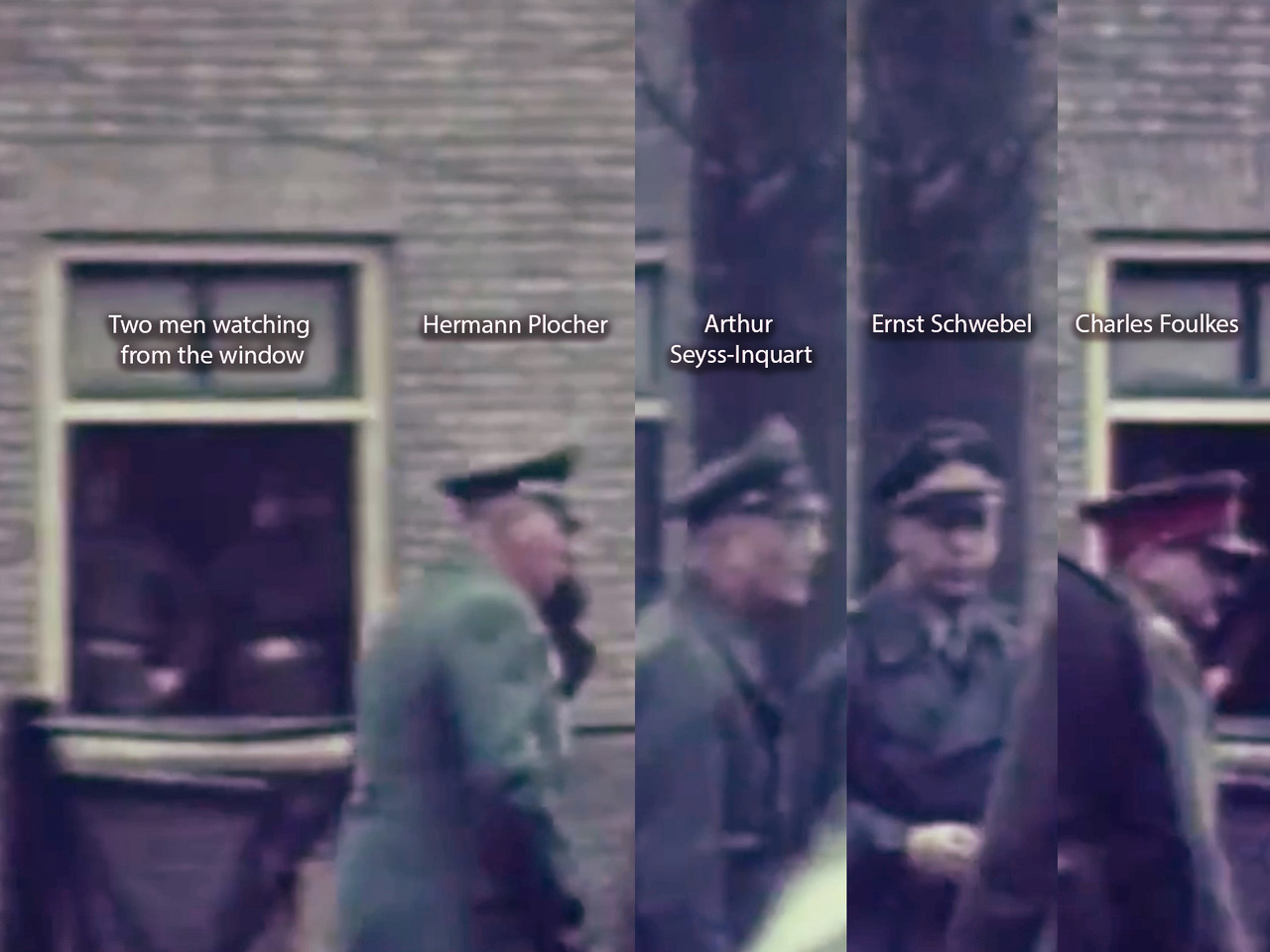







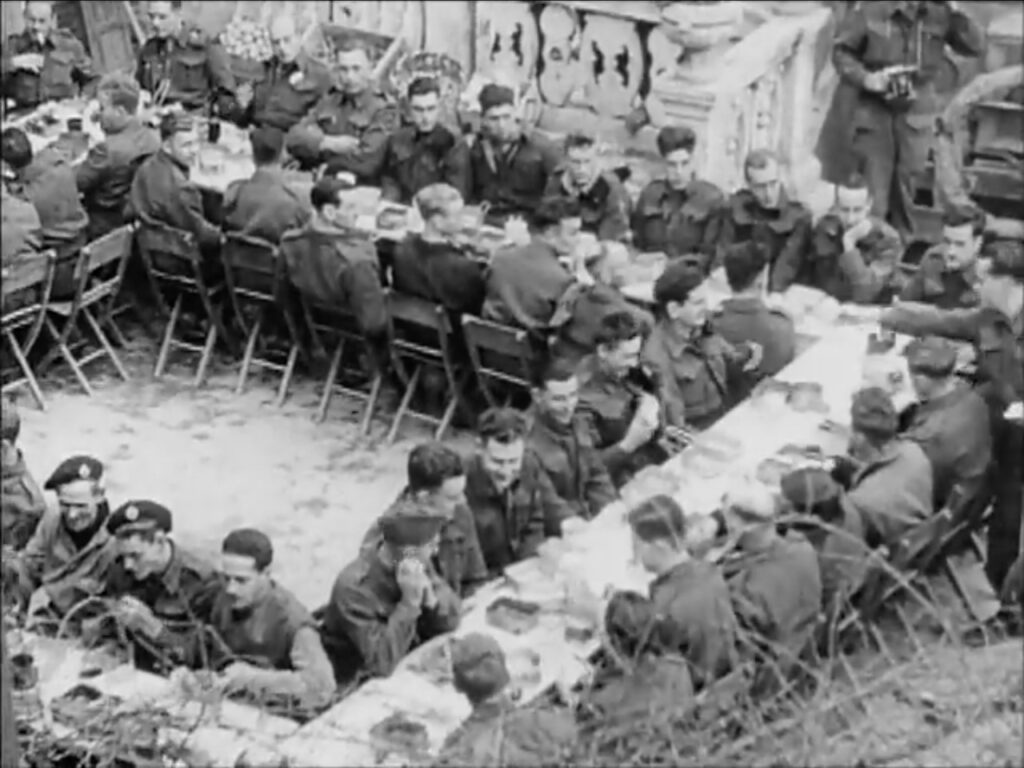
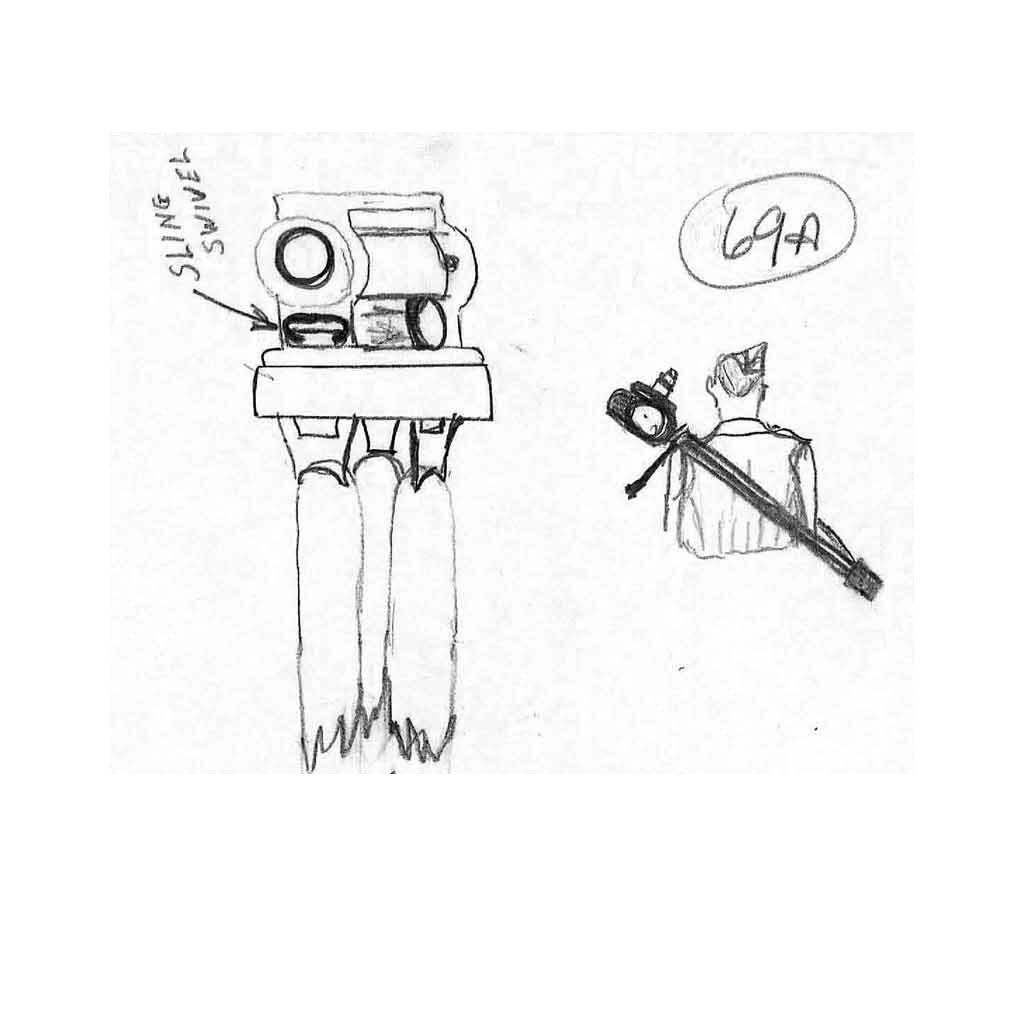
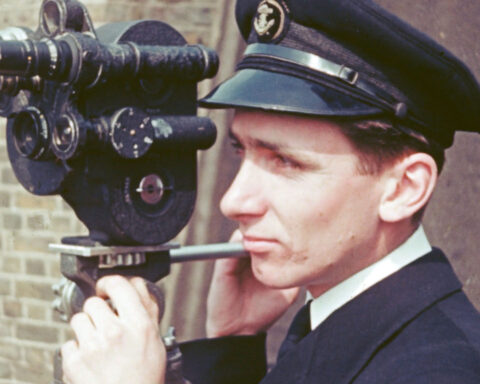
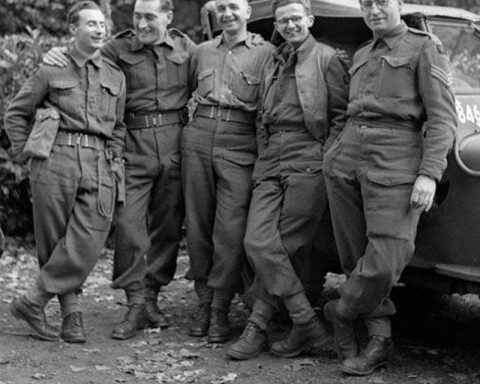
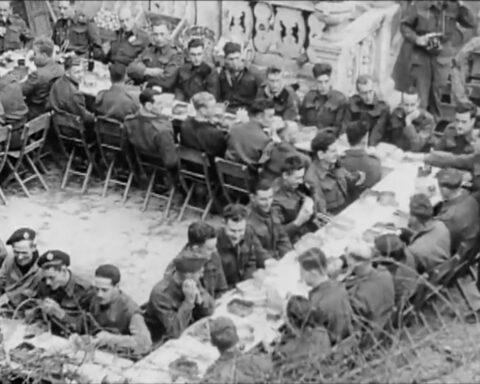
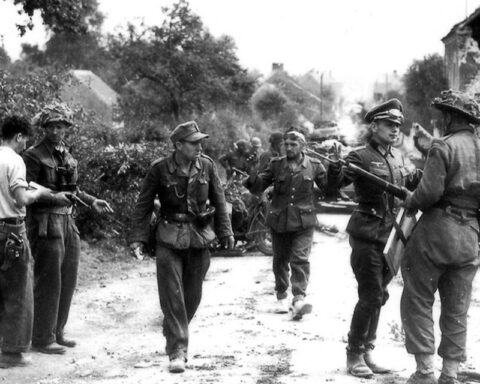
Thank you, this has been invaluable to me. General Plocher occupied my family house in Holland from May 5th – 10th 1945 and I have first hand diary accounts from my family of this time. Do you have any other images or info about Plocher around this time in May 1945?
Issy van Randwyck
Thank you very much Issy. I forwarded your comment to the author Ben Moogk. The Diary sounds fascinating! Dale.
Email replay from Ben Moogk;
“I did not go too deeply into the biography of Hermann Plocher. Charles Foulkes was disparaging about Plocher in a speech immediately after the war when discussing the negotiations, which was consistent with the expressions of disgust among other Allied representatives. I did not look at any primary evidence beyond that. I did see that in Plocher’s biography he had been rehabilitated for the rebuilding Luftwaffe during the Cold War. Ben”
Hello Issy van Randwyck
Could you please contact me by email voorzitter@hotel-dewereld.nl ?
My name is Jelle de Gruyter. I am board member of the Foundation National Heritage Hotel De Wereld in Wageningen, Holland. We are very interested in what is in the diaries of your family. At the moment we are making a book about what (really) happened those days in Achterveld and Wageningen, end of april – beginning of May 1945. Thank you in advance!
Thank you so much for getting back to me. I very much appreciate it.
The description of Plocher as ‘the stupidest soldier I ever dealt with’ is pretty damning. Might you be able to let me know where you found the quote? I have found mention of him in several chapters of the Canadian War Records of the Battle of the Reichswald and also have a copy of his Interrogation Report.
Best,
Issy
Issy,
I comes from a speech to the Empire Club on 5 October 1945. “Plocher” is misspelled as “Plocker”, but the early date of the recollection gives it weight. I do not think Plocher was stupid, but I do think the comment reflects the contempt many soldiers felt about the Germans. They had seen the atrocities and they were angry. I did want to illustrate the state of mind of the attendees at the Acherveld Conference. Foulkes was not popular among his peers at the time (he definitely is not ‘likeable’ in this speech), but soldiers do not criticise one another, and opinions mellowed when he showed political skills while in the Ottawa. The skills needed to advocate for the army that many an old warrior lacked in the years after the war. Plocher himself found some redemption.
“The Last Canadian Battle and the Surrender of the German Army”
https://speeches.empireclub.org
I enjoyed reading Ben Moogk “Deal with the Devil”. My father Robert Hilborn ( Major at the time) was one of only 2 GSO’s accompanying Gen Foulkes and BGen Kitching to Archterveld. I was hoping to find a photograph which includes him. If you supply me with an email I can forward some material that my father had sent to Dr JL Granatstein at the Canadian War Museum.
Cheers
Lynn Hilborn (Mr.)
Hi Lynn, thank you so much for contacting me. You can reach me at webmaster@canadianfilm.com. Try searching the Army Numerical albums; https://canadianfilmandphotounit.ca/2020/04/12/library-archives-canada-army-numerical-series-110-albums-now-available-online/ and look through the photos of Albums 100/101/102. Thanks. Dale.
Thank you for a fascinating account of the negotiations in Holland. I was only about 6 yrs old at that time and lived in Southampton U.K. but can still remember the events of those days.
I am attempting to assist a friend who wants to mark the grave of Lt. Ernie De Guire. He is buried in the Capital Memorial Gardens in Ottawa. I have just made contact with the Last Post Fund and they have been very responsive. However, I would like to find out some more details about him to make the process easier. I have an excellent photo of him in uniform that shows his shoulder flash as “Canadian Film/Photo . . . ”
Can you offer any more information about him?
I will accompany my friend (who is 86) to place a poppy on the grave on the 11th.
Hi Michael,
Thanks for contacting me.
I will do some research and gather what I can on Ernie DeGuire for you.
The best way to share any information or photos you may have on DeGuire can be best sent via email to webmaster@canadianfilm.com.
If you encounter any issues with file size, I have found WeTransfer a good and free service to use to share large files.
Please keep me posted when you are in Ottawa with your friend. Maybe a chat and/or a meeting to hear more about your story, and maybe share what each of us has about DeGuire for a possible post on the website. I will do some digging this weekend and gather what I have.
Sincerely,
Dale Gervais
webmaster@canadianfilm.com
Ottawa, CANADA